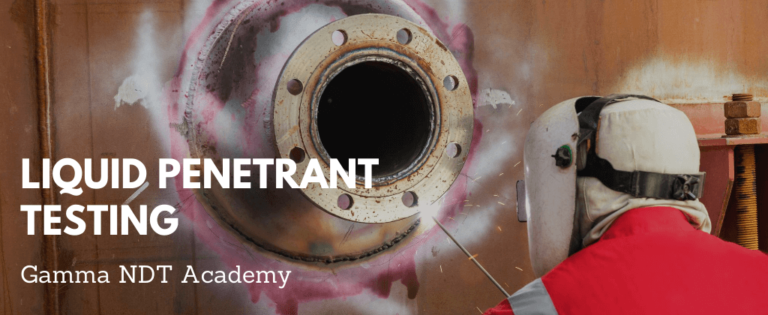
02 Aug Liquid Penetrant Testing in NDT – Course Details and Syllabus
Liquid penetrant testing is also known as Dye penetrant testing or Liquid penetrant inspection(LPI). It’s a cost effective and widely used type of non destructive testing used to detect surface breaking flaws or discontinuities like cracks, laps, surface porosity, fractures etc. Also liquid penetrant testing is one among the most popular types of NDT.
Usually LPI is used to identify forging, casting and weldments defects. The liquid penetrant can be applied to both ferrous as well as non-ferrous materials. As it is a portable testing , it can also be tested on-site. And by using different techniques like visible colour contrast, testing can be performed without the need of additional resources like electricity or water. LPI requires minimal training compared to other ndt testings. History says the first documented penetrant testing happened in the early 1900s in the railroad industry.
Principle behind the Technique
Liquid penetrant testing is performed based on the capillary action in which the low surface tension fluids are penetrated to the dry and very clean surface with discontinuities. The application of penetrant is by dipping, brushing or by spraying. Once the allowed penetration time is over, the excess penetrant applied on the surface is removed. Then the developer is applied on the surface. This step is done in order to make the invisible indication of the flaw visible to the inspector by drawing the penetrant out of the flaw. The testing is done under white or ultraviolet light based on the type of the used dye i.e fluorescent / non-fluorescent. LPI can be used to detect very narrow cracks even up to 150 nano metres and the broader indication provides easy visibility of the cracks.
Materials Used
Based on the sensitivity levels, the penetrants are divided into different types. They are fluorescent and non-fluorescent.
Fluorescent penetrants containing two or more dyes fluoresce when it is excited by UV-A radiation which is also termed as black light. This testing is performed in a dark environment where the excited dyes can emit yellow-green light perfectly. And this sort of testing is better sensitive to defects than the other type.
Visible penetrants or non-fluorescent are in red colour and it provides the lowest sensitivity to defects.
Also, the liquid penetrant testing required 3 spray cans (aerosol), adequate visible light and some cloth which is lint free.
Steps or Process involved in Liquid Penetrant Testing
- Pre-Cleaning Section
In this pre-cleaning section the surface is cleaned or de-greased to remove the dirt, oil, grease, dust or any other loose scales that could hinder the penetration of the fluid to the defect or give false or irrelevant indications. Main objective of this process is to get a clean surface where the defects or cracks will be dry and open to the surface and should be free of contamination. This process can be done by using alkaline cleaning steps, solvents, media blasting or by vapor greasing. Since in media blasting the small discontinuities are also worked over, iit is recommended to have an etching bath in a post-blasting method.
- Application of Penetrant
Basically the penetrant is applied to the surface of the testing item by spraying penetrant from the can (aerosol) or by using the brush. It can also be applied by dipping the testing item. After that, the pentrant is allowed a dwell time for the penetrant to get soaked in to the flaws or cracks. Generally the dwell time will be about 5 to 30 minutes and should not be kept more than that or long enough which causes the penetrant to get dry. For smaller flaws the penetration time will be longer. It’s recommended not to apply solvent-based penetrant to surfaces where it should be inspected with a water-washable penetrant since the solvent-based penetrant has an incompatible nature.
- Removal of Excess Penetrant
In this step the excess penetrant is removed by using the removal method which is decided by the type of penetrant used. Different removal methods are there such as solvent-removable, water-washable, hydrophilic post-emulsifiable, or lipophilic post emulsifiable. Mainly the removal methods are in types of emulsifiers,lint-free cloth and solvent removers. Emulsifiers have the highest sensitivity level and interact chemically with the penetrant which is oily and will make it removable with water spray. In case of solvent removable and lint-free cloth, the solvent should not be sprayed directly on the test surface since it can remove the penetrant soaked in the flaws.
- Application of Developer
After the removal of excess penetrant, the developer which is very thin coating is applied on the testing item. Different types of developer are available like water soluble, water suspendable, dry powder and non-aqueous wet developer. The type of developer is selected by analyzing the inspection conditions and the penetrant compatibility. The testing sample should be dried prior to the application of dry powder and non-aqueous wet developer. And in case of suspended and soluble developers can be applied in the surface which is already wet from the earlier process. The developer should be kept for the dwell time for about 10 to 60 minutes.
- Test Surface Inspection
In this step the visible light with the necessary intensity i.e 1100 lux is used for the visible dye penetrant. And for fluorescent penetrant examinations, UV-A radiation of required intensity (1k micro-watts) is used. Depending on the testing sample, the tested surface should be placed for about 10 to 30 minutes time in the development process. The inspector will analyse the tested sample using the visible dye.
- Post-Inspection Cleaning
As the last step, the tested surface is cleaned after the process of inspection.
Advantages and Disadvantages of Liquid Penetrant Testing
Advantages
- LPI is high sensitivity which allows it to detect even the small discontinuities.
- Inexpensive and fast inspection for large areas and volumes is possible.
- Required minimal amount of training.
- Visual representation can be easily presented directly on the surface of the part.
- It is Portable
- Materials required are less.
- Can be used to inspect parts with complex shapes easily.
- Cost-effective since materials and equipment are relatively inexpensive.
Disadvantages
- Can be used only for open surface defects.
- Materials with nonporous surfaces only can be inspected and porous surfaces cannot be detected.
- Cleaned surfaces are mandatory since contaminants or dirt can hide the defects.
- Post cleaning is required for the parts or materials.
- The surface should be directly accessible to the inspector.
- Inspection sensitivity can get affected even by surface finish and roughness.
- Multiple steps or processes should be performed as well as controlled.
- Should remove all the Metal smearing from grinding,machining and vapor or grit blasting must be removed prior to the liquid penetration.
- Proper handling and chemical disposal is required.
So liquid penetration testing does not have many limitations and is a portable method so that it can be used as a fast and inexpensive method among all NDT techniques.
Enroll for 1 month preparatory classes for ASNT level 2 and 3 Liquid Penetrant Testing Certification
Gamma NDT academy offers NDT preparatory classes for candidates who intend to appear for the ASNT Level 2 and 3 Liquid Penetrant Testing certification exam.
We will cover all the syllabus under ASNT for Liquid Penetrant testing and conduct mock tests to prepare you best for the certification exam. We will also share study materials and sample questions which you need to revise. We have a 100% success rate for NDT level 2 and 3 certification courses.
Gamma NDT academy training institute is located in Kerala, India. We provide online classes for candidates who cannot attend our training sessions in-person.



No Comments